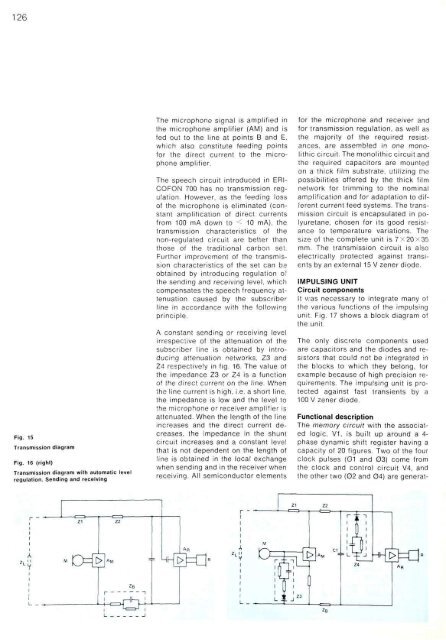geostationary telecommunications satellites electronic telephone set ...
geostationary telecommunications satellites electronic telephone set ...
geostationary telecommunications satellites electronic telephone set ...
You also want an ePaper? Increase the reach of your titles
YUMPU automatically turns print PDFs into web optimized ePapers that Google loves.
126<br />
Fig. 15<br />
Transmission diagram<br />
Fig. 16 (right)<br />
Transmission diagram with automatic level<br />
regulation. Sending and receiving<br />
The microphone signal is amplified in<br />
the microphone amplifier (AM) and is<br />
fed out to the line at points B and E,<br />
which also constitute feeding points<br />
for the direct current to the microphone<br />
amplifier.<br />
The speech circuit introduced in ERI-<br />
COFON 700 has no transmission regulation.<br />
However, as the feeding loss<br />
of the microphone is eliminated (constant<br />
amplification of direct currents<br />
from 100 mA down to < 10 mA), the<br />
transmission characteristics of the<br />
non-regulated circuit are better than<br />
those of the traditional carbon <strong>set</strong>.<br />
Further improvement of the transmission<br />
characteristics of the <strong>set</strong> can be<br />
obtained by introducing regulation of<br />
the sending and receiving level, which<br />
compensates the speech frequency attenuation<br />
caused by the subscriber<br />
line in accordance with the following<br />
principle.<br />
A constant sending or receiving level<br />
irrespective of the attenuation of the<br />
subscriber line is obtained by introducing<br />
attenuation networks, Z3 and<br />
Z4 respectively in fig. 16. The value of<br />
the impedance Z3 or Z4 is a function<br />
of the direct current on the line. When<br />
the line current is high, i.e. a short line,<br />
the impedance is low and the level to<br />
the microphone or receiver amplifier is<br />
attenuated. When the length of the line<br />
increases and the direct current decreases,<br />
the impedance in the shunt<br />
circuit increases and a constant level<br />
that is not dependent on the length of<br />
line is obtained in the local exchange<br />
when sending and in the receiver when<br />
receiving. All semiconductor elements<br />
for the microphone and receiver and<br />
for transmission regulation, as well as<br />
the majority of the required resistances,<br />
are assembled in one monolithic<br />
circuit. The monolithic circuit and<br />
the required capacitors are mounted<br />
on a thick film substrate, utilizing the<br />
possibilities offered by the thick film<br />
network for trimming to the nominal<br />
amplification and for adaptation to different<br />
current feed systems. The transmission<br />
circuit is encapsulated in polyuretane,<br />
chosen for its good resistance<br />
to temperature variations. The<br />
size of the complete unit is 7x20X35<br />
mm. The transmission circuit is also<br />
electrically protected against transients<br />
by an external 15 V zener diode.<br />
IMPULSING UNIT<br />
Circuit components<br />
It was necessary to integrate many of<br />
the various functions of the impulsing<br />
unit. Fig. 17 shows a block diagram of<br />
the unit.<br />
The only discrete components used<br />
are capacitors and the diodes and resistors<br />
that could not be integrated in<br />
the blocks to which they belong, for<br />
example because of high precision requirements.<br />
The impulsing unit is protected<br />
against fast transients by a<br />
100 V zener diode.<br />
Functional description<br />
The memory circuit with the associated<br />
logic, V1, is built up around a 4-<br />
phase dynamic shift register having a<br />
capacity of 20 figures. Two of the four<br />
clock pulses (01 and 03) come from<br />
the clock and control circuit V4, and<br />
the other two (02 and 04) are generat-
















